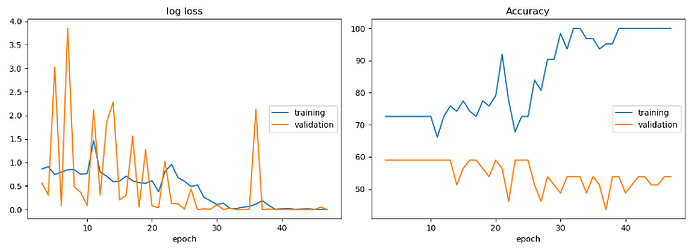How do I improve validation accuracy ? I am using a Conv3d the shape of the data is such (1,1,20,256,265) batch_size = 1.
I am getting the following result:
I tried adding dropout layers but they don’t help much in this case. Can this be the result of fewer data in validation set? Dataset is already unbalanced.
code:
class CNNModel(nn.Module):
def __init__(self):
super(CNNModel, self).__init__()
# Convolution 1
self.cnn1 = nn.Conv3d(in_channels=1, out_channels=20, kernel_size=5, stride=1, padding=2)
self.relu1 = nn.ReLU()
self.dropout1 = nn.Dropout(p=0.1)
# Max pool 1
self.maxpool1 = nn.MaxPool3d(kernel_size=2)
# Convolution 2
self.cnn2 = nn.Conv3d(in_channels=20, out_channels=40, kernel_size=5, stride=1, padding=2)
self.relu2 = nn.ReLU()
self.dropout2 = nn.Dropout(p=0.1)
# Max pool 2
self.maxpool2 = nn.MaxPool3d(kernel_size=2)
#Convolution 3
self.cnn3 = nn.Conv3d(in_channels=40, out_channels=60, kernel_size=5, stride=1, padding=2)
self.relu3 = nn.ReLU()
self.dropout3 = nn.Dropout(p=0.2)
# # Max pool 3
self.maxpool3 = nn.MaxPool3d(kernel_size=2)
# Dropout for regularization
self.dropout5 = nn.Dropout(p=0.5)
# Fully Connected 1
self.fc1 = nn.Linear(122880, 3)
def forward(self, x):
# Convolution 1
out = self.cnn1(x)
out = self.relu1(out)
out = self.dropout1(out)
# Max pool 1
out = self.maxpool1(out)
# Convolution 2
out = self.cnn2(out)
out = self.relu2(out)
out = self.dropout2(out)
# Max pool 2
out = self.maxpool2(out)
# Convolution 3
out = self.cnn3(out)
out = self.relu3(out)
out = self.dropout3(out)
# Max pool 3
out = self.maxpool3(out)
# # Max pool 2
# out = self.maxpool4(out)
# # Resize
out = out.view(out.size(0), -1)
# print('flattening', out.size())
# Dropout
out = self.dropout5(out)
# Fully connected 1
out = self.fc1(out)
return out
model = CNNModel()
liveloss = PlotLosses()
model.to('cuda:0')
criterion = nn.CrossEntropyLoss()
optimizer = torch.optim.Adam(model.parameters(), lr=learning_rate)
for epoch in range(num_epochs):
logs = {}
total_correct = 0
total_loss = 0
total_images = 0
total_val_loss = 0
model.train()
for i, (data, target) in enumerate(train_loader):
images = Variable(data).to('cuda:0')
labels = Variable(target).to('cuda:0')
optimizer.zero_grad()
# Forward propagation
outputs = model(images)
# Calculating loss with softmax to obtain cross entropy loss
# loss = criterion(outputs, labels)
loss = criterion(outputs, labels) #....>
# Backward prop
loss.backward()
# Updating gradients
optimizer.step()
# Total number of labels
total_images+= labels.size(0)
# Obtaining predictions from max value
_, predicted = torch.max(outputs.data, 1)
# Calculate the number of correct answers
correct = (predicted == labels).sum().item()
total_correct+=correct
total_loss+=loss.item()
logs['log loss'] = total_loss / total_images
logs['Accuracy'] = ((total_correct / total_images) * 100)
print('Epoch [{}/{}], Step [{}/{}], Loss: {:.4f}, Accuracy: {:.2f}%'
.format(epoch + 1, num_epochs, i + 1, len(test_loader), (total_loss / total_images),
(total_correct / total_images) * 100))
